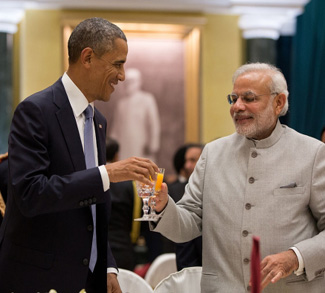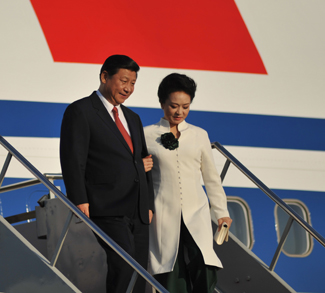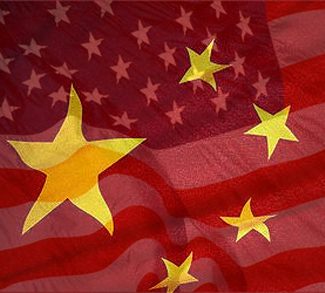US President Barack Obama stuck to a clear foreign policy agenda over his first term in office: disengage from the Middle East and ‘rebalance’ US political, economic, and military assets towards East Asia. This latter goal came to be known as the ‘Pivot.’
The Pivot took a long-term view of US interests, far longer than the passing commitments of Iraq and Afghanistan that President Obama inherited from his successor. In theory it sought to deepen bilateral aid and trade links, human rights promotion, diplomatic engagement, and military cooperation with governments throughout East Asia. In practice the Pivot would further entrench US power and influence in East Asia and preclude the possibility of a Chinese threat against US military and trade flows through this geopolitically crucial region. Yet quite unlike the blunt antagonism of the Cold War era, the Pivot envisioned a softer, more nimble approach whereby a US presence would act as a crutch for middle powers to hold their own ground against Beijing should the need arise – a containment ‘lite.’
The policy was met with harsh criticism from the Chinese government, who view it as a thinly-veiled attempt to stymy China’s legitimate rise as a global power.
The Pivot Three Years On
The world has changed since the term ‘Pivot’ first entered the punditry lexicon back in 2011. For one, the first goal of President Obama’s foreign policy – US disengagement from the Middle East – has proven far more elusive than originally hoped. The war with ISIS looks to be the next big US policy quagmire, and it is threatening to wipe out what little strategic traction Washington gained over a decade of war and occupation. This is an issue that will continue to draw US wealth, policy focus, and military assets towards the Middle East and away from East Asia, a region that was supposed to be earmarked as one of key strategic importance in the decades to come.
Russia’s recent actions in Ukraine have also led to calls for a more robust US military commitment to Europe, further distracting from the Obama administration’s priorities in East Asia.
This all smacks of a terminal strategic drift to many outside observers, which is why every Asia trip by President Obama is met with a volley of articles trumpeting the Pivot’s premature demise. Yet in many ways this characterization isn’t justified. The Pivot has produced several notable successes in line with its original aim of promoting political, economic, and military links with the region. On the diplomatic front, the United States has joined the East Asia Summit, and now has a permanent ambassador to ASEAN – a forum that is taking the lead in trying to find a diplomatic solution to territorial disputes in the South China Sea. Economically Washington has strengthened bilateral trade and aid exchanges with Cambodia, Laos, Thailand, and Vietnam, even if the US-spearheaded Trans-Pacific Partnership (TPP) is floundering for the time being. And in the military sphere, where many of the Pivot’s most obvious successes lie, the Obama administration has negotiated new basing rights with Australia, the Philippines, and Singapore. It also appears that the US Navy is still committed to stationing 60% of its forces in the region by 2020.
The question then becomes: Are these successes enough to achieve the Pivot’s secondary aim of providing a credible hedge against a rising China? And it’s here where the waters get muddied.
Think of the Pivot as a classic case of diminishing returns. For the time being it might be inserting the United States into the security equation such that Beijing cannot impose its will on regional governments and settle disputes unilaterally; however hard it might try in the South China Sea. But time and geography are simply not on Washington’s side. With every passing year that China’s economic and military clout expands, so too does the base commitment from Washington that would be necessary to convince regional governments that the United States is a reliable partner over the long term.
So even if the Pivot could be considered a success so far, it’s one in which the returns are at constant risk of disappearing. Maintaining the Pivot’s momentum will take more political will, more money, and more military deployments in the years to come. This is a chess match where the odds are stacked against Washington, the power with global interests, from the very beginning. It’s a lot easier for China to focus on its own immediate backyard and wait for the inevitable distraction that diverts finite US resources and ends up damaging trust among US allies.
Nowhere are these disparate focuses more apparent than in aid and investment flows. Consider the fact that the Chinese government just pledged over $20 billion in loans to ASEAN countries to help build infrastructure and drive regional trade. This is part of a two-track approach to relations with the region, the pro-development ‘carrot’ to go along with the ‘stick’ being brandished in territorial disputes in the South China Sea. By way of contrast, the United States has spent over $104 billion on reconstruction in Afghanistan since 2002.
Myanmar – The ‘Canary’ of the Pivot
Myanmar is an illustrative case, both in terms of the Pivot’s potential for success and its potential for failure down the line. This is a country that up until now could hardly be considered a natural ally to the United States, yet it has ingratiated itself by embracing political reform, and in 2012 it saw its first ever visit from a US president. The motivations behind Myanmar’s shift towards Washington are as simple as they are common throughout the region. It’s not a case of the United States being ‘good/benevolent’ or China ‘bad/threatening,’ but rather a practical need to bring a powerful third party into what would otherwise be an uneven bilateral negotiation.
This is the appeal of the Pivot, because it allows middle powers to form triangular relationships with Washington and Beijing, playing the larger powers off against each other and ultimately getting a better deal out of it.
But just as Myanmar has been a notable success so far, it could one day portend the Pivot’s doom. Rapprochement with the United States comes at the cost of antagonizing Beijing, which is apt to view such developments through a zero-sum lens. For Myanmar, there’s a risk of crossing a line where the damage to relations with nearby China eclipse the utility of closer cooperation with the far-off United States. Where exactly this line lies depends not just on how committed the United States actually is to remaining a force in East Asia, but how committed it’s perceived to be by regional governments like Myanmar.
Myanmar can thus be viewed as a ‘canary’ for the Pivot. Although it stands to gain from a triangular alignment between Washington and Beijing, in the eyes of the reform-minded government of President Thein Sein, much has already been paid out in exchange for the country’s rehabilitation. Given that the reform drive appears to be waning ahead of upcoming elections and pressure is mounting on Washington to firmly denounce sectarian violence in Rakhine, Myanmar could well shift out of the success column, and in doing so deal a huge blow to US credibility in the region.
Conclusion
In its attempt at a more diffuse, indirect, and soft-power oriented approach, the Pivot was a bold policy move in its own right; it turned to a new-age playbook to achieve an age-old aim. But like the wars in Afghanistan and Iraq, it’s easier getting in than getting out. The Obama administration has anted up US credibility in its long-term plans for the region, and it’s going to take a lot more money and effort to have this defining policy pay off in the long run.




